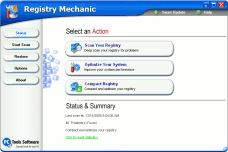Instant Screen Saver (Do not add water!)
Windows 98/ME/NT/2000/XP
Most of us still use screen savers, not because they're necessary to protect
our monitors (they're not necessary because newer monitors do not get "screen
burn"), but because we like them. And most of us have our screen saver to come
on after a certain period of inactivity - let's say ten or fifteen minutes - and
then the only screen saver that will start is your "default" screen saver. But
you don't have to wait, and you don't have to look at your default screen saver;
you can chose any screen saver, create a shortcut to it, and start it anytime
you want.
Instant Screen Savers might be for you!
Many screen savers feature beautiful photographs and soothing music; so
perhaps some beautiful pictures and
music would help you to relax. An instant "beauty" break to help you relax in
today's instant world!
Instantly starting a screen saver can come in handy at other times too. Like
when you're at work and you're playing "Frogger" on your company computer and
your boss walks in the room. Simply click your handy-dandy instant screen saver
shortcut, and your screen is covered by
beautiful
autumnal scenery . Grab a pen and some paper and quickly scribble some kind
of fancy equation and the boss will think you're busy working or unlocking the
secrets of the human genome. Frogger may still be running in the background,
though, so you might want to turn off your sound :)
With this tip, you'll be able to create shortcuts to your favorite screen
savers that will allow you to instantly start them without waiting for your
default screen saver to automatically start.
Things you need to know about screen savers:
- All Windows screen savers have the extension ".scr"
- All screen savers are executable (meaning they "run" when clicked"
- Most Windows screen savers can be found in the following directories
a. C: \Windows
b. C: \Windows\System 32
- All versions of Windows install with some default screen savers. These screen
savers have icons which look like these:

Now that you've learned all about screen savers you're ready to make
shortcuts to them.
Browse through the C:\ Windows and C: \Windows\System 32 directories and look
for files ending with the ".scr" extension. If you've installed some screen
savers from sites on the Web they most likely will appear in one or other other
of these directories too, although they may have different icons. When you find
a screen saver you want to create a shortcut to, simply right-click it and
choose:
"Send to" --->Desktop (Create Shortcut)
You can then drag your new shortcut on the desktop to your start button or your Quick Launch
taskbar for easy access, or you can leave it on your desktop if you don't mind
the clutter :-) Just click on the shortcut to start the screen saver
instantly.
A word about screen savers
While these days, screen savers are not necessary to prevent "screen burn", they
remain one of the most popular downloads on the Internet. You have to be careful
though. Many so-called "Free Screen Savers" are full of spyware, adware,
hijackers, Trojans, and worse. So before you go off and download a free screen
saver, make sure you know what you're getting. Just because a developer says "No
Adware" "No Spyware" doesn't make it so. Check the reputation of the developer
by doing a search for the name of the company that makes the screen savers. For
instance "Freeze.com" is one of the Web's biggest distributors of free screen
savers - and unfortunately one of the Web's most successful distributors of
adware and possible spyware.
Most of you know that we offer over
one hundred free screen
savers that are spyware/adware free (really). And some other sites do too.
Just be careful that you use your brains and check things out - first. Because
after you install something, it might be too late to correct it. Think before
you click "OK".

